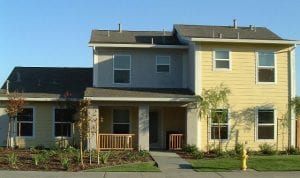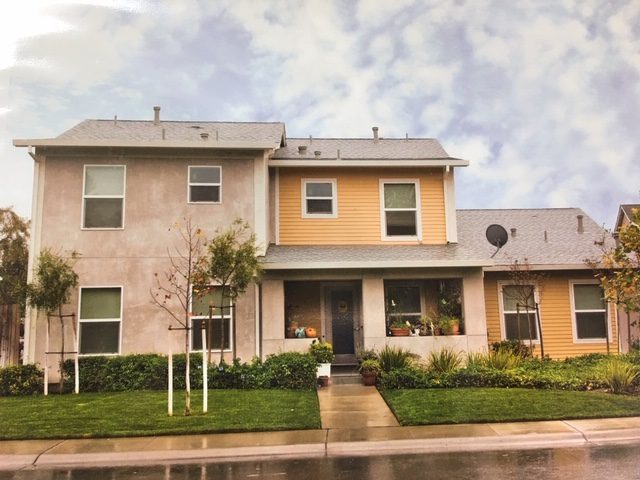
Moore Village yellow triplex. Photo courtesy of David J. Thompson
Moore Village is a low-income development nestled in a high-income neighborhood in the college town of Davis, California. When it was first proposed in 2001, Moore Village looked like it might never get built.
In October 2001 about 100 angry neighbors showed up for a tense neighborhood meeting at the Wildhorse Golf Club to discuss plans for a vacant 5-acre site. It was at that city-sponsored public meeting that homeowners of the upscale Wildhorse area in north Davis learned that 59 low-income apartments were to be built in the middle of their community, only 300 feet away from the golf course. The apartments would specifically be rented to extremely low, very low, and low-income households.
Accusations flew, tempers rose, and distrust was rampant. Of the seven low-income projects that Neighborhood Partners LLC has developed in Davis, this was the project with by far the most opposition.
The meeting was dominated by a vocal opposition of people who worried that their home values would be reduced by the addition of low-income apartments; that the single family nature of the neighborhood would be spoiled by out-of-town renters; and that crime would rise, traffic would increase, and local schools would be severely impacted. Others claimed that real estate agents had promised them that the site was going to be a park or a senior housing complex despite the fact that the homebuyers had all been provided with city maps showing that the site was reserved for low-income housing.
[RELATED ARTICLE: What Is NIMBYism and How Do Affordable Housing Developers Respond to It?]
Some of the homeowners hired a local attorney who, at the meeting, pointedly raised various regulatory challenges to the city’s planning process for the proposed project. The attorney hinted at a lawsuit that would delay the project for at least two years if the developers tried to move ahead.
At the time, Wildhorse was the latest single-family subdivision built on the outskirts of the city. Home prices in the neighborhood were the highest of any of the other subdivisions in the area. Currently the median list price in Wildhorse is $873,000, according to Realtor.com.
Being aware of the neighborhood’s opposition to the project, Neighborhood Partners LLC, an organization that develops nonprofit housing, and where I serve as co-principal, sat down with Richard Berteaux, the project’s architect, to think through how we could respond to the substantial resistance voiced at the neighborhood meeting.
The site provided for enough affordable units to meet the city’s inclusionary zoning requirement, but it had sat empty for years while all the market-rate homes in the subdivision were built and sold. At that time, the city council preferred not to develop the site. Under California law, if a jurisdiction could show that it had land on which it could build low-income housing to meet regional targets, cities were not required to actually add any more affordable housing. In 2002, the city had three vacant affordable housing sites, the oldest being unused for almost a decade. (Recently the council has been more inclined to require that low-income housing be built in the first phase of new developments, but most cities in California have also now substantially reduced their targets for affordable inclusionary housing.) So we had to get the neighbors on board in order for the project to be approved.
Making Changes to Moore Village Plans
In 2002, for fire and safety reasons, the city’s planning department wanted entrances and exits on two sides of the Moore Village development. However, an entry and exit through one roadway in particular—Hartley Street—would put a fair amount of Moore Village traffic through a single-family neighborhood. To foster an attractive interior community, we told city planners that we couldn’t accommodate this request and wanted one entrance and exit onto Moore Boulevard. Although many of the Wildhorse area residents did not approve of the Moore Village project, the neighbors to our north, east, and west did strongly oppose the city’s request, and the city backed off from fighting that many neighbors.
That was one compromise that helped lead the project to planning approval.
For 2002 to 2004, I regularly met with neighbors whose properties were near or adjacent to Moore Village. For instance, I met with each of the neighbors whose fenced backyards backed up to the south side of Moore Village where a new driveway would enter Moore Boulevard. In the end, new fences, large boulders, and landscaping were added to the plan to keep the backyards of homes on Leonardo Street from views of Moore Village and the lights of vehicles leaving it at nighttime. The $75,000 spent on the improvements bought us buy-in from the Leonardo Street neighbors.
Quite often, apartment buildings are constructed with the parking lots on the exterior, which are unattractive and often generate noise complaints from neighbors. We decided to place all the parking and traffic circulation within the interior of Moore Village. We wanted the neighbors to know that we were designing Moore Village traffic to not disturb the quiet neighborhood.
We also looked at what we could do to make the apartments attractive to neighbors, as they had worried that the look of these homes would lower their property values. I went out to the area on several occasions to look at the single-family homes that either faced or backed up onto our site. I specifically looked at how we could make our low-income rental housing blend with the homes directly facing the site.
Neighborhood Buy-in
During the summer months of 2002, prior to the city’s planning commission hearings, I put ads in the local paper saying I would be available at the site on weekends to speak with the neighbors. I placed all the plan’s details and updates on a card table at the vacant lot, along with a large sign inviting Wildhorse neighbors to stop and talk. Thanks to our numerous meetings with neighbors from 2001 to 2002, we anticipated what they would like.
I got to talk to the neighbors who took their daily walk along Moore Boulevard. I was also able to get some neighbors passing in cars to stop and look at the plans. Face-to-face interaction tends to invite questions rather than challenges. Getting neighborhood buy-in was critical to getting project approval.
I then asked interested neighbors to hold house parties and invite 10 of their neighbors to go over the plans with the architect and myself. About six months and five house parties later, homeowners were convinced by the changes we had made that we were sincerely accommodating neighborhood feedback.
In the end, we came up with a design solution that was unique, attractive, and shifted the initial perceptions people had of low-income housing.
The design was meant to look as much like a single-family home as possible, even though they were actually triplexes. All of the homes were to have a similar dimensions and setback as the neighbors across the road.
To lower the visual profile of this low-income community, we chose not to have “Moore Village” signage directly on the street. We specifically designed the single Moore Village entrance to curve behind the trees and landscaping and hide the interior parking. From Moore Boulevard, Moore Village now looks more like an understated upscale condo development.
A memorable moment occurred late in the construction process. As I was looking at the Moore Village triplexes, something seemed visually peculiar. I then realized that there were no paths from any of the eight front doors to the sidewalk. It turned out that without mentioning it to anyone, the architect had personally thought it would make the neighbors happier if there were no visible paths to the front doors of the homes.
So here were these eight single-family looking homes along two streets that had no paths to the door. Exiting for fire or safety reasons could be impeded without a concrete path to the street. It also meant that the residents of that apartment could open the front door onto the porch, but there was no way to get to the street or easily carry groceries or furniture from a car to their home.
However, at this late stage in 2004, there were no paths on the approved plans. Constructing paths required going back through the hearing process to gain the approval of the city’s planning commission and the city council.
Once again, I set off to meet with each of the neighbors. I explained how this mistake had been made. Fortunately, with the Moore Village homes now being mostly finished, the attractive single-family replica was appreciated by the Wildhorse neighbors. With their support, the city approved the paths and they were added during the last months of construction. By 2005, Moore Village was occupied.
Neighborhood opposition to affordable housing is an ongoing reality. There are too many unknowns, and rumors easily spread when homeowners in small towns and the suburbs are told low-income rental housing will be built in their neighborhood. It seemed to me that subtle racism or a bias against low-income renters played a role in Wildhorse neighborhood opposition as it does in many places. But overt discrimination never surfaced at Wildhorse. Good design, responsiveness to the neighbors, and engagement pushed the topic off the page.
Countering with clear information, not being defensive, and having a willingness to make meaningful adjustments are critical tools with which to respond. Meeting with small neighborhood groups in their homes and listening to their concerns are important steps. Looking for shared solutions and being willing to make changes are key factors. Both affordable housing proponents and neighbors must cultivate flexibililty.
Through patience and respect by both sides, what first looked like combat ended up becoming cooperation. We are grateful that because of our early interactions, neighborhood leaders saw us as a design team that was eager to work with them. The early perception of dense, unattractive, urban-looking three-story apartment blocks was slowly dispelled. The combined two-year input and interaction of both parties eventually crafted an attractive affordable housing community. In a way, the quality of the ultimate design helped change the perception the neighbors had of who would be living there.






I am trying to reach David J. Thompson. He was instrumental in the development of Dos Pinos in Davis, CA.